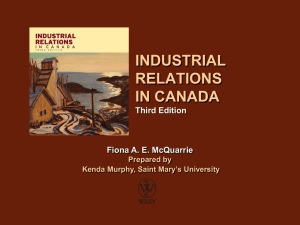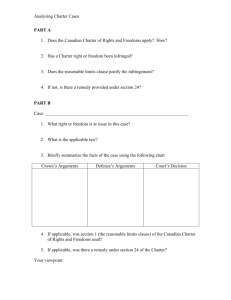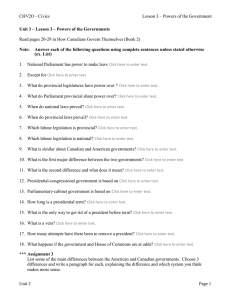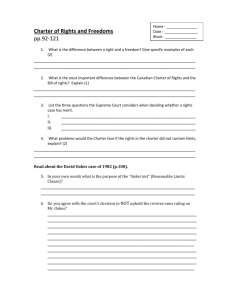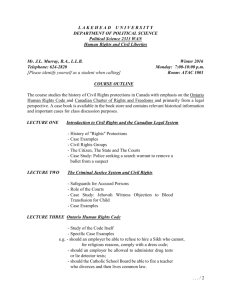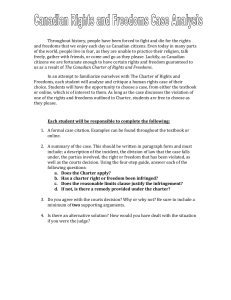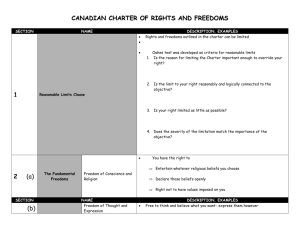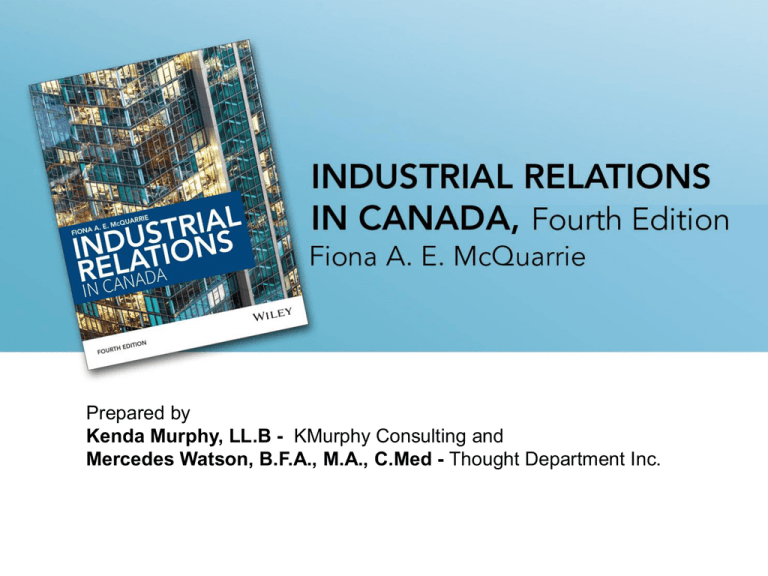
Prepared by
Kenda Murphy, LL.B - KMurphy Consulting and
Mercedes Watson, B.F.A., M.A., C.Med - Thought Department Inc.
Chapter
An Introduction to
Industrial Relations in Canada
1
Chapter 1 Objectives
1
• At the end of this chapter, you should be able to:
Identify the various terms used to describe
union-management relationships
Describe how different academic subjects might
address industrial relations issues
Identify the major pieces of legislation that regulate
Canadian industrial relations and explain what they
have in common
Understand how other kinds of Canadian legislation
affect industrial relations
Explain some of the major demographic and statistical
features of Canadian union membership
What Is Industrial Relations?
1
• Industrial relations:
Refers to the relationship between a union
and an employer
• The difference between Industrial Relations (IR)
and Human Resource Management (HR) is that
IR refers to employment relationships in a unionized
environment, whereas HR deals with employment
relationships in all types of organizations.
Industrial Relations in Academia
1
Industrial Relations is a stand alone area of
study but is also found in many other academic
fields such as:
History, Psychology, Economics, Political
Science, Law and Sociology
The Legal Framework
1
• Jurisdiction
Union-employer relations may be governed
by federal or by provincial legislation
Until the mid-1920s, all IR issues were covered
by federal laws
In 1925, case of Snider vs. Toronto Electrical
Commission established that industrial relations were
mostly a provincial responsibility
Federal Jurisdiction
•
1
Any business that operates interprovincially,
in that it crosses provincial boundaries,
is covered by federal labour laws
• Examples of interprovincial businesses are
banking, telecommunications, broadcasting
and interprovincial transportation
• Federal government and Crown Corporation employees
are also covered by federal laws
Provincial Jurisdiction
•
Provincial labour law covers businesses that
operate within the boundaries of that province
(intraprovincially)
Provincial law covers 90 percent of
union-employer relationships in Canada
1
Types of Laws Covering Labour Relations
1
Labour Relations Laws
•
Federal and provincial labour relations acts share
common characteristics:
Establishing union certification procedures
Setting the minimum term for collective agreements
between employer and union
Establishing procedures for legal strikes
and lockouts
Establishing dispute resolution mechanisms
Defining unfair labour practices
Creating a labour relations board
Public Sector Labour Relations Legislation
•
1
Para-public or quasi-public sector legislation
• These laws cover government employees and/or
employees of agencies and bodies affiliated with
the government
• These employees work in organizations that are funded
by the government but they are not directly paid by the
government
• Examples: health care workers, court workers, employees
of colleges and universities
Other Relevant Legislation
•
Employment Standards Legislation
• Human Rights Legislation
• Canadian Charter of Rights and Freedoms
1
Human Rights Legislation
•
1
Exists in every jurisdiction
• Prohibits discrimination —intentional or systemic—on the
basis of personal characteristics or attributes, known as
protected or prohibited grounds
• Sometimes the requirements of a job will,
by necessity, exclude certain people or allow only certain
candidates to apply
Human Rights Legislation
•
Implications for unions and employers:
Collective agreements must not contain
clauses that have the effect of discriminating
Unions and employers must not act in
a discriminatory fashion
1
The Charter of Rights and Freedoms
•
1
The Charter of Rights and Freedoms guarantees certain
basic rights and freedoms to all Canadians
• The Charter is the pre-eminent law in Canada
with two exceptions:
Laws that can be justified as imposing reasonable
limits in a “free and democratic society”
Laws passed by invoking the
“notwithstanding” provision
The Charter of Rights and Freedoms
•
The Charter broadly defines a number
of fundamental rights
• Major cases involving industrial relations
issues have focused on these rights:
Freedom of association—right to join a union
Freedom of peaceful assembly—right to picket
Freedom of thought, belief, opinion,
and expression—right to promote union belief
and philosophy
1
The Charter of Rights and Freedoms
1
• Key early Charter cases:
Dolphin Delivery, 1982: Supreme Court of Canada
(SCC) ruled that Charter provisions do not apply
to court orders resolving common-law-based disputes
between private parties
The “labour trilogy,” 1990: SCC ruled that the
right to belong to a union is protected by the Charter,
but the rights to strike and bargain collectively are not
Lavigne, 1991: The Supreme Court ruled that
mandatory union dues do not violate the Charter
The Charter of Rights and Freedoms
1
Other important cases…
•
Dunmore v. Ontario (Attorney-General), 2001: The
Supreme Court ruled that the right to freedom of
association was violated if an entire class of workers—
e.g., farm workers—was excluded from protection under
labour legislation
• However, while Ontario changed its law to allow
agricultural workers to unionize, that law does not allow
them to engage in collective bargaining
The Charter of Rights and Freedoms
Health Services and Support case – SCC
(2007) – BC’s Bill 29 was ruled
unconstitutional on the basis that the right to
collective bargaining was part of the freedom
of association guaranteed by the Charter
• Plourde v. Wal-Mart Canada Corp [2009]
SCC – The Court ruled that the employees’
right to freedom of association was not
violated when their unionized store was closed
•
1
Characteristics of the
Unionized Workplace in Canada
•
1
A unionized workplace is more likely to be in the
public sector and to have a large workforce
• Rates of unionization are similar across broad
industrial categories, but there are wide variations
across different occupations
• Union membership is slightly higher among women
and older workers
• Union members are relatively well-educated and likely
to be full-time employees
Overview of Text
1
Chapter 1
• Introduces theoretical and historical background,
explains evolution of Canadian workplaces and
relevant legislation
Chapter 2
• Overview of theories and research addressing
creation of unions, and how unions’ purpose
have changed over time
Chapter 3
• Historical events and forces affecting evolution
of Canadian labour relations
Overview of Text
Chapter 4
• Structure of Canadian unions: national,
provincial, municipal and local organizations
Chapter 5
• Why employees may or may not wish
to join a union
Chapter 6
• How a labour relations board assesses
certification application
1
Overview of Text
Chapter 7
• The effects of a certification order
Chapter 8
• The four stages of collective bargaining
Chapter 9
• Strikes and lockouts
Chapter 10
• Third-party intervention: conciliation, mediation
and arbitration
1
Overview of Text
Chapter 11
• Grievances and the Arbitration Process
Chapter 12
• Changes during the collective agreement:
successorship; raiding and union mergers;
decertification; technological change and
workplace restructuring
1
Overview of Text
Chapter 13
• Recent changes in the Canadian workplace
and their implications for unions and employers
• Recent changes to labour legislation
and their implications for the future of
union-employer relationships
• Effects of globalization on industrial relations
1
Copyright
1
Copyright © 2015 John Wiley & Sons Canada, Ltd. All rights reserved.
Reproduction or translation of this work beyond that permitted
by Access Copyright (The Canadian Copyright Licensing Agency)
is unlawful. Requests for further information should be addressed
to the Permissions Department, John Wiley & Sons Canada, Ltd.
The purchaser may make back-up copies for his or her own use
only and not for distribution or resale. The author and the publisher
assume no responsibility for errors, omissions, or damages caused
by the use of these files or programs or from the use of the information
contained herein.

